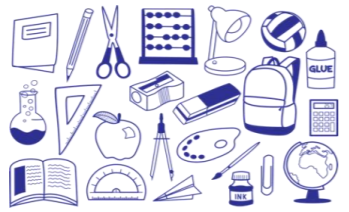2.1: La salle de classe
- Page ID
- 107962
In this section, you will learn how to:
- Talk about items in the the classroom
- Count to 100
Listen to the audio clips that follow on this page to hear the French pronunciation of vocabulary and examples presented.
On étudie !
In the video below, these two students talk about what items there are in their classroom.
Listen to their conversation and repeat.
| Français | Anglais |
|---|---|
| Il y a + articles indéfinis (un, une, des) + nom | There is, are + (a, some) + noun |
Pour en savoir plus.
| Français | Anglais |
|---|---|
| Voici, voilà + articles indéfinis (un, une, des) + nom | (T)here is, are + (a, some) + noun |
| Voici, voilà + articles définis (le, la, l', les) + nom | (T)here is, are + (the) + noun |
Pour en savoir plus.
La salle de classe

"This work" by pixabay.com is in the Public Domain, CCO
| Français | Anglais |
|---|---|
| un, une camarade de classe | a classmate |
| un copain (m.) | a friend |
| une copine (f.) | a friend |
| un(e) ami(e) | a friend |
| un(e) étudiant(e) | a student |
| une femme | a woman |
| un homme | a man |
| un livre | a book |
| une carte (du monde) | a (world) map |
| un dictionnaire | a dictionary |
| un classeur | a folder |
| un cahier | a notebook |
| une feuille de papier | a sheet of paper |
| un stylo | a pen |
| un crayon (à papier) | a pencil |
| une gomme | an eraser |
| un ordinateur | a computer |
| une imprimante | a printer |
| un sac à dos | a backpack |
| le tableau (noir, blanc) | the black, white board |
| une activité | an activity |
| un exercice | an exercise |
| un devoir, les devoirs | homework |
| les études | studies |
| une conversation | a conversation |
| un, une professeur | a professor |
| le, la prof (casual) | the professor |
| une table | a table |
| une chaise | a chair |
| une corbeille à papier | a waste basket |
| le vocabulaire | the vocabulary |
| la grammaire | grammar |
| absent(e) | absent |
| une dictée | dictation |
| une phrase | sentence, phrase |
| un paragraphe | paragraph |
| une feuille d'activités | activity sheet |
| l'emploi du temps | class schedule |
| l’horaire | schedule |
| le calendrier | the calendar |
| une épreuve | a quiz |
| un examen | an exam |
| un résultat | a result |
| la porte | the door |
| une fenêtre | a window |
| une salle de classe | a classroom |
| les notes | grades |
Study the Quizlet vocabulary flashcards. Listen and repeat the French pronunciation.
Watch this video to review and practice pronouncing school words in French: Learn French with Alexa.
Many anglicisms in French come from the world of computers and the internet. Here are some French equivalents you should know:
| Français | Anglais |
|---|---|
| chercher | to search |
| cliquer | to click |
| télécharger | to download |
| mettre en ligne | to upload |
| la page web, la page Internet | webpage |
| le site Internet, le site web | website |
| le texto | text |
| le mél | |
| le courier électronique, un courriel | electronic mail |
| les médias sociaux, les réseaux sociaux | social media |
| le lien | link |
| le hashtag, le mot-dièse | hashtag |
| le mobile multifonction, le smartphone, le téléphone intelligent | smartphone |
| une tablette (tactile) | tablet, ipad |
| l'écran (m.) | screen |
| la fenêtre | window |
| le logiciel | software |
| numérique (adj.) | digital |
Study the Quizlet vocabulary flashcards. Listen and repeat the French pronunciation.
D'autres anglicismes : web, Internet, Wi-Fi, site, spam, Twitter, Instagram, image, virus, page, routeur Wi-Fi, etc.
"Email" has multiple translations. The direct translation is courier électronique (electronic mail). The French also use the anglicisms e-mail, emails and mail, but today most say mél. In Canada, people will often say courriel.
Visit Top 20 Words You'll Need for the Internet to learn how to pronounce these words and expressions.
Les numéros 61-100
| Chiffres | Nombres | Chiffres | Nombres | Chiffres | Nombres | Chiffres | Nombres |
|---|---|---|---|---|---|---|---|
| 61 | soixante et un | 71 | soixante et onze | 81 | quatre-vingt-un | 91 | quatre-vingt-onze |
| 62 | soixante-deux | 72 | soixante-douze | 82 | quatre-vingt-deux | 92 | quatre-vingt-douze |
| 63 | soixante-trois | 73 | soixante-treize | 83 | quatre-vingt-trois | 93 | quatre-vingt-treize |
| 64 | soixante-quatre | 74 | soixante-quatorze | 84 | quatre-vingt-quatre | 94 | quatre-vingt-quatorze |
| 65 | soixante-cinq | 75 | soixante-quinze | 85 | quatre-vingt-cinq | 95 | quatre-vingt-quinze |
| 66 | soixante-six | 76 | soixante-seize | 86 | quatre-vingt-six | 96 | quatre-vingt-seize |
| 67 | soixante-sept | 77 | soixante-dix-sept | 87 | quatre-vingt-sept | 97 | quatre-vingt-dix-sept |
| 68 | soixante-huit | 78 | soixante-dix-huit | 88 | quatre-vingt-huit | 98 | quatre-vingt-dix-huit |
| 69 | soixante-neuf | 79 | soixante-dix-neuf | 89 | quatre-vingt-neuf | 99 | quatre-vingt-dix-neuf |
| 70 | soixante-dix | 80 | quatre-vingts | 90 | quatre-vingt-dix | 100 | cent |
Pay close attention to numbers 70, 80 and 90:
- The number 70 is actually "sixty-ten", (soixante-dix) in French. It then goes "sixty-eleven" (soixante-onze), "sixty-twelve" (soixante-douze), "sixty-thirteen" (soixante-treize), etc.
- The number 80 is quatre-vingts which means “four-twenties” (because four twenties equal eighty, right?). It is also the only number that pluralizes the word vingt (quatre-vingts). It then goes "four-twenty-one" (quatre-vingt-un), "four-twenty-two" (quatre-vingt-deux), "four-twenty-three" (quatre-vingt-trois), all the way to "four-twenty-nineteen" (quatre-vingt-dix-neuf).
- The number 90 is quatre-vingt-dix, literally "four twenty ten" (4 x 20 +10; or 80+ 10; you do the math).
- Once you get past 100, it’s easy; you just start all over again except you have the word “cent” in front of everything: cent un, cent deux, cent trois,... , cent vingt-trois,... , cent quatre-vingt-dix, etc.
On pratique !
Activité A
Qu’est-ce qu’il y a dans la salle de classe ? Let's ask each other what objects are found in the classroom.
Étudiant(e) 1 : Qu'est-ce qu'il y a dans la salle de classe ?
Étudiant(e) 2 : Il y a des chaises et un tableau.
Pratiquez ➔
Étudiant(e) 1 : Qu'est-ce qu'il y a dans la salle de classe ?
Étudiant(e) 2 : Il y a ________.
Activité B
Qu’est-ce qu'il n'y a pas dans la salle de classe ? Let's ask each other what is not found in the classroom.
Étudiant(e) 1 : Qu'est-ce qu'il n'y a pas dans la salle de classe ?
Étudiant(e) 2 : Il n'y a pas d'éléphants ou de tigres dans la classe.
Pratiquez ➔
Étudiant(e) 1 : Qu'est-ce qu'il n'y a pas dans la salle de classe ?
Étudiant(e) 2 : Il n'y a pas de ________.
Activité C
Qu'est-ce qu'il y a sur le bureau ? Et combien ? Regardez la photo et dîtes (say) ce qu'il y a sur le bureau et combien. Écrivez vos réponses.
Modèle : Il y a onze livres sur le bureau.
 "This work" by pixabay.com is in the Public Domain, CC0
"This work" by pixabay.com is in the Public Domain, CC0- ________.
- ________.
- ________.
- ________.
Activité D
Sur le campus. With a partner, take turns acting out these roles to talk about what there is and isn't on your campus. Follow the model and use the texte in bold :
Modèle :
Étudiant(e) 1 : Il y a combien de restaurants universitaires ?
Étudiant(e) 2 : Il y en a deux.
- professeurs de français : 3
- employés dans la librairie : 5
- professeurs à Palomar College : 56
- ordinateurs dans la bibliothèque : 43
- télévisions dans la salle de classe : 0
Activité E
Qu'est-ce qu'il y a dans ton sac à dos ? Make a list of six different items that you have in your backpack, then work with a partner to compare your answers.
| Moi | Mon, ma partenaire |
|---|---|
| Dans mon sac à dos, il y a... | Dans le sac à dos de ________, il y a... |
| 1. | 1. |
| 2. | 2. |
| 3. | 3. |
| 4. | 4. |
| 5. | 5. |
| 6. | 6. |
Activité F
Avec un(e) partentaire, posez-vous ces questions et répondez-y :
- Sur ton téléphone, y a-t-il une appli Facebook, Twitter, Whatsapp, TikTok, ou Instagram ?
- As-tu un compte mél de l’université Palomar ?
- Sur ton ordinateur, y a-t-il des films téléchargés d’Internet ?
Activité G
Imagine that you are in class with other classmates. You want to take out various items in your backpack or bag and say what they are in French. Write 5 sentences below, like the model, using “voici” or “voilà” to list the items in your bag.
Modèle : Voilà un petit cahier bleu.
- ________
- ________
- ________
- ________
- ________
Activité H
Samira is in her French class. She is listing objects in her classroom. Fill in her sentences with the appropriate article: un, une, des,de, d’.
Dans la salle de classe,
- Il y a_____________ordinateurs.
- Il y a_____________étudiants.
- Il y a _____________porte.
- Il y a______________fenêtres.
- Il y a______________horloge.
- Il n’y a pas______________tableau noir.
Activité I
Cherchez sur Internet :
- Go to the following site: Gibert
- Find un livre, un stylo rouge, un stylo bleu, un cahier, un agenda.
- Combien ça coûte ? Write down the price of each item you find.
- Write down your answers below, follow the model.
Modèle : Un cahier du professeur coûte douze euros dix (12€10).
- ________
- ________
- ________
- ________
- ________
On approfondit !
Use the following resources to type accents and/or search for words:
- Accents: ç, à, é, è, â, ê, î, ô, û, ù, ë, ï, ü
- Dictionnaire français-anglais

